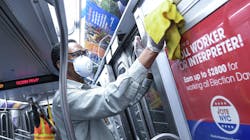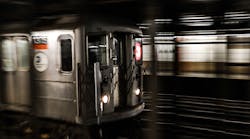New York MTA outlines plans for first nightly shutdown
New York City’s Metropolitan Transportation Authority (MTA) is preparing to begin nightly shutdowns of its subways as it continues to combat the spread of the COVID-19 virus. MTA is increasing bus service, evaluating new cleaning methods and working with its community partners to ensure the impact of the shutdown on essential riders is minimized.
Beginning May 6, the subway will close from 1:00-5:00 a.m. to allow MTA to execute what it calls the most aggressive cleaning and disinfecting regimen in its history. The cleaning efforts will include around-the-clock efforts at all facilities, including those of New York City Transit (NYCT), the Long Island Rail Road, Metro-North Railroad, MTA Bridges and Tunnels and MTA Construction & Development.
"During this pandemic it is critical that we keep our transit workers and the public safe," said New York Gov. Andrew M. Cuomo. "The MTA's plan to disinfect every train in the New York City subway system every 24 hours without disrupting service is a monumental undertaking and something that has never been done before, and we will continue to do everything we can to protect our essential workers who have kept this entire society functioning during these difficult times."
Like other transit systems, subway ridership has dropped 92 percent and bus ridership has dropped more than 80 percent below normal levels during the pandemic. However, MTA says an average of 11,000 customers, about 2.5 percent of NYCT’s essential customer base, continues to ride the subways during the planned shutdown timeframe. To continue serving essential workers during the shutdown, MTA is launching the MTA Essential Plan Night Service, which increases the number of bus trips by 1,168 (more than 76 percent) and adding 344 new buses on top of the 235 already deployed, increasing the operational fleet by nearly 150 percent during the 1:00-5:00 a.m. period.
“Our customers will probably see more cleaners underground than they ever have before,” said Sarah Feinberg, interim president of NYCT. “We know this program dramatically changes things for the essential workers who still need to travel overnight. But we will get all essential employees where they need to go.”
The cleaning that will take place during the shutdown will target both public and employee facilities. The MTA is investigating innovative methods to eradicate traces of COVID-19. Currently, three antimicrobial biostats are being applied to the interior of MTA rolling stock and in control rooms and crew quarters. The antimicrobial biostats are applied after the surfaces are cleaned and disinfected with an EPA-registered disinfectant. These products lay down a protective colorless, odorless barrier on surfaces that does not allow germs to grow.
“The safety of our customers and employees is always our highest priority,” said MTA Chairman and CEO Patrick J. Foye. “Overnight closure of the subway will allow us to take our cleaning operation to a never-before-seen level. We will more aggressively and efficiently disinfect our full fleet of rolling stock every single day. Touch points at stations will be cleaned twice daily. We’ve never undertaken so challenging a task, and as Governor Cuomo has said, it’s going to take a herculean effort.”
MTA is also evaluating the effect ultraviolet light (UV) has on the virus that causes COVID-19. MTA explains SARS-CoV-2 is one of the viruses UV light is proven to eliminate from surfaces. This pilot will focus on the use of UVs to eradicate SARS-CoV-2 from MTA’s rolling stock and fixed locations. In March, MTA worked with Columbia University and a UV startup to successfully demonstrate the efficacy of UV technology in its subway system. MTA will pilot this technology in its transit and railway vehicles in the second week of May but will focus on subways and buses.
Enforcing the system closure will be a collaborative effort between MTA Police and the New York City Police Department (NYPD). MTA says officers will be deployed to all 472 subway stations to make sure work proceeds uninterrupted. MTA also says it will continue to work in partnership with the NYPD to connect more homeless New Yorkers with access to the medical care and social services they need and deserve. The NYPD has intensified patrols and presence at all stations. Shuttle buses will be strategically placed at select stations to help transport unsheltered New Yorkers.

Mischa Wanek-Libman | Group Editorial Director
Mischa Wanek-Libman is director of communications with Transdev North America. She has more than 20 years of experience working in the transportation industry covering construction projects, engineering challenges, transit and rail operations and best practices.
Wanek-Libman has held top editorial positions at freight rail and public transportation business-to-business publications including as editor-in-chief and editorial director of Mass Transit from 2018-2024. She has been recognized for editorial excellence through her individual work, as well as for collaborative content.
She is an active member of the American Public Transportation Association's Marketing and Communications Committee and served 14 years as a Board Observer on the National Railroad Construction and Maintenance Association (NRC) Board of Directors.
She is a graduate of Drake University in Des Moines, Iowa, where she earned a Bachelor of Arts degree in Journalism and Mass Communication.


